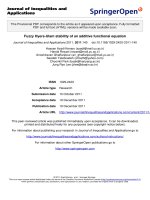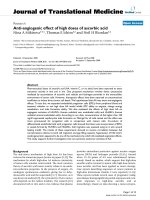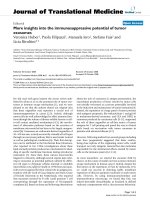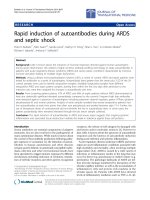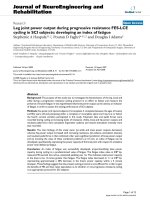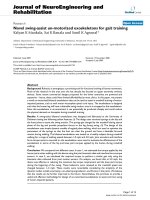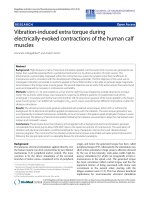báo cáo hóa học:" Narrow band imaging (NBI) during medical thoracoscopy: first impressions" pptx
Bạn đang xem bản rút gọn của tài liệu. Xem và tải ngay bản đầy đủ của tài liệu tại đây (561.02 KB, 4 trang )
BioMed Central
Page 1 of 4
(page number not for citation purposes)
Journal of Occupational Medicine
and Toxicology
Open Access
Research
Narrow band imaging (NBI) during medical thoracoscopy: first
impressions
Nicolas Schönfeld*, Carsten Schwarz, Jens Kollmeier, Torsten Blum,
Torsten T Bauer and Sebastian Ott
Address: Lungenklinik Heckeshorn, HELIOS Klinikum Emil von Behring, Berlin, Germany
Email: Nicolas Schönfeld* - ; Carsten Schwarz - ;
Jens Kollmeier - ; Torsten Blum - ; Torsten T Bauer - torsten.bauer@helios-
kliniken.de; Sebastian Ott -
* Corresponding author
Abstract
Background: This is the first ever evaluation of narrow band imaging (NBI), an innovative
endoscopic imaging procedure, for the visualisation of pleural processes.
Methods: The pleural cavity was examined in 26 patients with pleural effusions using both white
light and narrow band imaging during thoracoscopy under local anaesthesia.
Results: In the great majority of the patients narrow band imaging depicted the blood vessels more
clearly than white light, but failed to reveal any differences in number, shape or size. Only in a single
case with pleura thickened by chronic inflammation and metastatic spread of lung cancer did
narrow band imaging show vessels that were not detectable under white light.
Conclusion: It is not yet possible to assess to what extent the evidence provided by NBI is
superior to that achieved with white light. Further studies are required, particularly in the early
stages of pleural processes.
Thoracoscopy is the standard diagnostic procedure for
investigating exudative pleural effusions and leads to a
conclusive diagnosis for 95% of patients when carried out
under local anaesthesia [1]. Thoracoscopy can also be
employed for staging primary thoracic malignancies, i.e.
malignant pleural mesotheliomas or primary malignant
pulmonary tumours with possible pleural dissemination.
Despite the high diagnostic yield of thoracoscopy under
local anaesthesia, some patients still remain without a
conclusive diagnosis or have to undergo a surgical proce-
dure under general anaesthesia. Apart from the conven-
tional white light, other imaging procedures that are said
to yield more information, especially at to the presence of
a pleural tumour, have already been investigated, but the
evidence has remained limited [2-4].
Narrow band imaging (NBI) is a new, alternative light-
wavelength capture system that takes advantage of altered
blood vessel morphology. Wavelengths of light in the vis-
ible spectrum are filtered from the illumination source,
with the exception of narrow bands in the blue and green
spectrum centered at 415 nm and 540 nm, coinciding
with the peak absorption spectrum of oxyhemoglobin,
making blood vessels more pronounced when viewed in
Published: 26 August 2009
Journal of Occupational Medicine and Toxicology 2009, 4:24 doi:10.1186/1745-6673-4-24
Received: 5 July 2009
Accepted: 26 August 2009
This article is available from: />© 2009 Schönfeld et al; licensee BioMed Central Ltd.
This is an Open Access article distributed under the terms of the Creative Commons Attribution License ( />),
which permits unrestricted use, distribution, and reproduction in any medium, provided the original work is properly cited.
Journal of Occupational Medicine and Toxicology 2009, 4:24 />Page 2 of 4
(page number not for citation purposes)
NBI mode [5]. We present the first ever results with NBI in
a series of patients with pleural processes.
Methods
Medical thoracoscopy was performed under local anaes-
thesia and conscious sedation, using a prototype OLYM-
PUS XLTF-160 pleuravideoscope in single hole technique
[6]. Following removal of the pleural fluid, the pleural
cavity was inspected at first under white light and then
under NBI as described elsewhere for bronchoscopy [5,7].
Afterwards, biopsies were taken from macroscopically
altered sites. We used the OLYMPUS EVIS EXERA II video
system (CV-180 videoprocessor and CLV-180 light
source) manufactured by Olympus Medical Systems
Corp., Japan. The findings were analysed retrospectively.
Results
The results are summarised in Table 1. A total of 15
women (median age 66 years) and 11 men (median age
64 years) with pleural effusions were examined. Biopsies
of the parietal pleura or diaphragm were taken for all but
one of these patients. Only in patient #26 NBI showed
more vessels than white light (fig. 1 and 2). In all other
patients, there was either no difference, or blood vessels
merely appeared more prominent (example in fig. 3 and
4).
Discussion
Our first examinations of the pleural cavity with NBI have
indicated that in cases with diffuse spread of malignant
tumour no substantial improvement in diagnoses is to be
expected. Whereas the blood vessels in the region of the
tumour tissue that was already identifiable macroscopi-
cally were more clearly depicted, the number of changes
rendered visible was no greater than with white light. This
was also true for mesothelioma patients. In the two cases
of non-specific pleuritis, in which the pleura did not
appear to be essentially thickened, the visualisation of the
blood vessels was similar under both white light and NBI.
Pleural cavity of patient #26 (lung cancer (adenocarcinoma), chronic inflammatory changes), white lightFigure 1
Pleural cavity of patient #26 (lung cancer (adenocar-
cinoma), chronic inflammatory changes), white light.
Pleural cavity of patient #26, NBIFigure 2
Pleural cavity of patient #26, NBI.
Pleural cavity of patient #2 (small cell lung cancer, large pol-yps), white lightFigure 3
Pleural cavity of patient #2 (small cell lung cancer,
large polyps), white light.
Journal of Occupational Medicine and Toxicology 2009, 4:24 />Page 3 of 4
(page number not for citation purposes)
As was to be expected, NBI also failed to demonstrate any
blood vessels in the deeper layers of pleural plaques typi-
cal of asbestos-related disease. However, a different situa-
tion was found in a single patient with pleura showing
chronic inflammatory changes, besides tumour polyps. In
this case distinctly more deeper blood vessels were identi-
fiable than under white light. To what extent this observa-
tion is indicative of an actual diagnostic advantage
cannot, however, be ascertained on the basis of this initial
series.
Other groups having used different procedures such as flu-
orescence techniques reported to have found more exact
indications of spreading of malignant pleural mesothelio-
mas [3,4]. However, the numbers of patients participating
in these studies were so small that it has not as yet been
possible to produce reliable evidence. It is possible that
the same applies to NBI, in so far as in some cases mes-
otheliomas are associated with the development of a con-
siderable amount of fibrotic tissue [8] and may thus not
be identifiable histologically in biopsies taken under
medical thoracoscopy. In such cases imaging of vascular
structures in deeper layers of a thickened pleura could give
some indication of from where the biopsy should best be
taken. However, until considerably larger numbers of
Pleural cavity of patient #2, NBIFigure 4
Pleural cavity of patient #2, NBI.
Table 1: Results of thoracoscopy in all patients (n = 26)
Pat. Gender Age Macroscopical findings Histological diagnosis
1 female 81 chronic inflammation, pleural thickening
(visceral and parietal)
chronic pleuritis (underlying disease: chronic renal failure)
2 male 74 multiple polyps (parietal) small cell lung cancer
3 male 69 small nodes (parietal), adhesions squamous-cell lung cancer
4 female 62 Adhesions, small nodes (parietal) malignant mesothelioma
5 female 58 small confluent nodes (parietal) breast cancer
6 male 59 pleural thickening (parietal) lung cancer (adenocarcinoma)
7 female 81 large nodes (parietal and visceral), adhesions malignant mesothelioma
8 male 47 large nodes (parietal), adhesions malignant mesothelioma
9 female 65 small confluent nodes (parietal) breast cancer
10 female 63 solitary node/polyp (parietal) ovarian cancer
11 female 68 acute inflammation, adhesions, lymphangiectasis breast cancer
12 male 64 small confluent nodes, polyps (parietal) malignant mesothelioma
13 male 85 large nodes, polyps (parietal and visceral) malignant mesothelioma
14 male 82 pleural plaques (parietal), adhesions squamous-cell lung cancer
15 male 64 pleural plaques (parietal), small confluent nodes malignant mesothelioma
16 female 88 multiple large nodes (parietal and visceral) lung cancer (adenocarcinoma)
17 female 37 acute inflammation, adhesions, pleural thickening tuberculous pleurisy
18 female 46 no abnormalities inflammatory changes
(underlying diease: squamous-cell lung cancer, effusion e vacuo)
19 female 63 subacute inflammation, pleural thickening malignant mesothelioma
20 female 63 large nodes, polyps (parietal and visceral) lung cancer (adenocarcinoma)
21 female 82 large confluent nodes, polyps (parietal and visceral) malignant mesothelioma
22 male 64 multiple small nodes, polyps (parietal and visceral) malignant mesothelioma
23 male 72 pleural thickening, solitary polyps squamous-cell lung cancer
24 male 66 pleural thickening, adhesions small cell lung cancer
25 female 80 large solitary nodes (parietal) breast cancer
26 female 67 large solitary nodes (parietal) and chronic
inflammatory changes
lung cancer (adenocarcinoma)
Publish with BioMed Central and every
scientist can read your work free of charge
"BioMed Central will be the most significant development for
disseminating the results of biomedical research in our lifetime."
Sir Paul Nurse, Cancer Research UK
Your research papers will be:
available free of charge to the entire biomedical community
peer reviewed and published immediately upon acceptance
cited in PubMed and archived on PubMed Central
yours — you keep the copyright
Submit your manuscript here:
/>BioMedcentral
Journal of Occupational Medicine and Toxicology 2009, 4:24 />Page 4 of 4
(page number not for citation purposes)
patients have been examined with NBI this remains spec-
ulation.
A second interesting question that could be investigated
in future clinical studies with NBI in pleural processes is
whether NBI were to be used intra-operatively to inspect
the pleura before planned resection of lung cancer [9].
This would facilitate detection of any previously unob-
served pleural dissemination at other locations. It is
already common in surgery for small effusions associated
with primary pulmonary malignomas to begin the opera-
tion under thoracoscopy and only to perform thoracot-
omy and continue with the resection if there are no signs
of pleural dissemination. If possible, studies of this kind
should not – as is so often done with innovative tech-
niques – be carried out at only a single centre, but be per-
formed as prospective, multicentre studies. It would thus
be possible to arrive at a more objective assessment of
such innovative techniques.
Abbreviations
NBI: narrow band imaging.
Competing interests of authors
The authors declare that they have no competing interests.
Authors' contributions
All authors have taken part in the procedures (thoraco-
scopies) and, thus, the interpretation of clinical and endo-
scpical findings. Drs. Schönfeld, Bauer und Ott have in
particular contributed to the retrospective analysis and
interpretation of data.
References
1. Loddenkemper R: Thoracoscopy – state of the art. Eur Respir J
1998, 11:213-221.
2. Prosst RL, Winkler S, Boehm E, Gahlen J: Thoracoscopic fluores-
cence diagnosis (TFD) of pleural malignancies: experimental
studies. Thorax 2002, 57:1005-1009.
3. Chrysanthidis MG, Janssen JP: Autofluorescence videothoracos-
copy in exudative pleural effusions: preliminary results. Eur
Respir J 2005, 26:989-992.
4. Baas P, Triesscheijn M, Burgers S, van Pel R, Stewart F, Aaldres M:
Fluorescence detection of pleural malignancies using 5-ami-
nolaevulinic acid. Chest 2006, 129:718-724.
5. Vincent BD, Fraig M, Silvestri GA: A pilot study of narrow-band
imaging compared to white light bronchoscopy for evalua-
tion of normal airways and premalignant and malignant air-
ways disease. Chest 2007, 131:1794-1799.
6. Munavvar M, Khan MA, Edwards J, Wagaruddin Z, Mills J: The auto-
clavable semirigid thoracoscope: the way forward in pleural
disease? Eur Respir J 2007, 29:571-574.
7. Shibuya K, Hoshino H, Chiyo M, Iyoda A, Yoshida S, Sekine Y, Iizasa
T, Saitoh Y, Baba M, Hiroshima K, Ohwada H, Fujisawa T: High mag-
nification bronchovideoscopy combined with narrow band
imaging could detect capillary loops of angiogenic squamous
dysplasia in heavy smokers at high risk for lung cancer. Tho-
rax 2003, 58:989-995.
8. Cury PM, Butcher DN, Corrin B, Nicholson AG: The use of histo-
logical and immunohistochemical markers to distinguish
pleural malignant mesothelioma and in situ mesothelioma
from reactive mesothelial hyperplasia and reactive pleural
fibrosis. J Pathol 1999, 189:251-257.
9. Sebastián-Quetglás F, Molins L, Baldó X, Buitrago J, Vidal G, Spanish
Video-assisted Thoracic Surgery Study Group: Clinical value of
video-assisted thoracoscopy for preoperative staging of non-
small cell lung cancer. A prospective study of 105 patients.
Lung Cancer 2003, 42:297-301.
